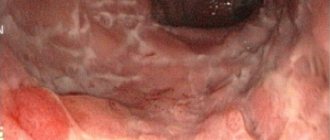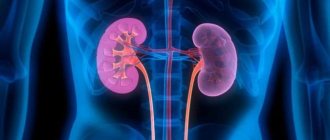Avonex is a drug created by genetic engineering with antiviral and immunomodulatory activity, an analogue of natural human interferon beta. From a chemical point of view, it is a complex glycosylated polypeptide consisting of almost 200 amino acids, the sequence of which corresponds to natural human interferon beta. The substance was synthesized based on the DNA of Chinese hamster ovary cells (Cricetulus griseus), one of the most common laboratory animals that provide cell cultures.
The dosage form of the drug is lyophilisate for intramuscular injection. Avonex is very expensive to produce and, although it is effective in treating many viral diseases, doctors now use it almost exclusively to treat relapsing multiple sclerosis, a severe chronic disease associated with damage to the central nervous system.
Causes
Typically, nerve fibers are covered with a protective layer of a fatty substance called myelin.
The functions of this layer are similar to the function of insulating electrical wires. In multiple sclerosis, immune cells begin to destroy the cells that produce the myelin layer. Myelin becomes damaged and peels away from the fibers.
Eventually the separated myelin is destroyed.
Densified (sclerotized) areas of scar tissue form on the nerve fibers. These damaged areas block or slow the passage of nerve impulses to or from the brain, often causing weakened muscles and poor coordination of movements and vision.
Other types of therapy and symptomatic treatment
Intravenous use of Solumedrol for multiple sclerosis effectively relieves attacks, restores body functions, and reduces the time of exacerbations. The exception is progressive sclerosis.
Strong effects and side effects have been noted (there may be mood swings, increased body weight, decreased immunity to various infections).
In cases where the use of the drug is not effective enough, the patient’s condition is improved by plasmapheresis (blood cells are separated from the plasma).
It is important to know! Only a doctor can prescribe medications for the treatment of multiple sclerosis. They cannot be used independently, because... harmful side effects detected!
Preventive drugs modify and slow down the disease: protect the myelin sheaths of neurons (Copaxone), protect the central nervous system from damage to immune cells.
Typical side effects: increased blood pressure, decreased visual acuity for a while, liver damage.
Drugs of the third group improve the well-being of patients and eliminate the manifestation of the disease. The use of vitamins (in particular group B), muscle relaxants, tonics, painkillers, non-steroidal, anti-inflammatory, antidepressants (Baclofen, Oxybutynin, etc.) is justified.
Studies have shown that the use of a diet enriched with vegetable oils, as well as fish oil, which contains eicosapentaenoic and deucosahexaenoic acids, helps reduce the frequency and severity of exacerbations of MS.
To correct impaired hemostasis, HBO is prescribed (100% 02, 2ata, 90 min, daily for 3 weeks). Improvement occurs in 50% of patients.
The frequency of exacerbations decreases over the next year. In a number of cases, satisfactory results were not obtained.
However, all studies noted an improvement in impaired pelvic organ functions. .
Among the medications, amantadine (midantan) is recommended, which is effective in 50% of cases, as well as the potassium channel blocker 4-aminopyridine (amiridine).
How does the development of the disease affect life?
Among diseases of the central and peripheral nervous system, multiple sclerosis leads in severity of complications. If you do not pay attention to prevention, drug delay in the spread of nerve fiber lesions and a healthy lifestyle, the disease can lead to loss of ability to work and even disability.
How do people with the early stages of multiple sclerosis live? The patient remains able to work and can be successfully employed in professions that do not require physical exertion, eye strain, or joint strain.
Multiple sclerosis and pregnancy - reviews, forum
To correctly assess the pros and cons of pregnancy with this disease, you need to consider in detail all aspects of the disease.
What is multiple sclerosis?
First of all, multiple sclerosis is a progressive process, which is based on demyelination of the nerve fibers of the central nervous system, characterized by a chronic course.
What is multiple sclerosis
How does pregnancy affect the development of multiple sclerosis?
Why is the problem of pregnancy in the presence of multiple sclerosis so important?
The problem of the relationship between multiple sclerosis (MS) and pregnancy is an important practical issue, since it has not only medical, but also socio-ethnic aspects.
If both parents, or one of the spouses, have multiple sclerosis, the decision to have a child should be an informed one. Such a baby will have a higher risk of getting sick than other children.
Multiple sclerosis - pregnancy is not a hindrance
Which drug based on the substance is recognized as the most effective and safe?
Cladribine is included in the following drugs:
- Vero-Cladribine (LENS-Pharm). Available in the form of a concentrate for the preparation of infusion solution (10 mg/10 ml).
- Leukladin (Belmedpreparaty). Produced in the form of a solution (10 mg/10 ml and 5 mg/5 ml).
- Movectro (Merck, UK), 10 mg tablets.
- Litac (Lipomed, Germany), bottles of 10 mg/ml.
- Mavenclad (Merc, UK).
Experts recommend refraining from taking domestic analogues. Of great importance is not only the coincidence of the name and dosage of the active substance, but also the correct selection of auxiliary components. This affects the bioavailability and effectiveness of the drug, and the severity of adverse reactions. Therefore, it is recommended to give preference to the drugs Litac, Mavenclad and Movectro.
But the latter is registered on the territory of the Russian Federation. Taking into account the imperfect legislative regulation of the circulation of medicines, this increases the risk of purchasing counterfeits.
Other types of therapy and symptomatic treatment
Symptoms and signs of the disease include:
- Numbness, weakness, or paralysis of one or more limbs;
- Short-term sensations of pain, tingling;
- Visual disturbances with pain when moving the eyes;
- Tremors, loss of coordination, or unsteady gait;
- Fatigue;
- Dizziness;
- Exacerbation and easing of signs and symptoms.
Multiple sclerosis usually occurs in episodes (bouts) that last for weeks or months, followed by periods of remission when signs and symptoms improve or disappear.
There may be permanent disability, and signs and symptoms may worsen. Apart from injuries, the disease is the leading cause of disability in adults before retirement age.
There are 5 main forms of multiple sclerosis:
- Benign. In 10-15% of patients, signs and symptoms remain mild or moderate. They do not get worse and do not lead to permanent disability.
- Recurrent. With this type, 1-2 deteriorations occur every 1-3 years, followed by periods of remission. The attacks develop within a few hours, last several weeks or months and then gradually fade away. Signs and symptoms may worsen with each subsequent attack. In approximately 85% of cases, multiple sclerosis begins with this form.
- Primary progressive. After the first appearance of signs and symptoms, this form develops without acute attacks or remissions. This picture of the disease is observed in approximately 15% of patients.
- Secondary progressive. After many years of the relapsing form, at least half of patients begin to experience a slow but continuous deterioration. Against this background, isolated outbreaks of the disease may occur.
- Progressive recurrent. This is primary progressive multiple sclerosis with sudden episodes of new signs and symptoms or worsening of existing ones. This form occurs in less than 5% of patients.
Symptoms and characteristics of pain syndrome in pathology
The symptoms of the disease are invisible at first, and then quite varied. Signs of the disease may appear one at a time or multiple times. The stages of exacerbation and remission are unpredictable. Remissions can last from several hours to several years; attacks occur unpredictably. As a rule, after a long remission, periods of exacerbation are more pronounced. The causes of relapse can be any psychological or physical stress on the body - a cold, alcohol abuse, overwork, nervous shock and more.
Among the main signs of the disease are the following:
- Pelvic disorders;
- Changes in emotional and mental state;
- Injury to cranial nerves;
- Musculoskeletal disorders;
- Cerebellar disorders;
- Deterioration of sensitivity.
All these violations are reflected in the patient’s real life. For example, vision deteriorates, the ability to perceive colors is lost, vision begins to double, and the movements of the eyeballs become uncoordinated. A person experiences frequent headaches, the main causes of which are depression and muscle strain. Speech becomes confused, and difficulties often arise with swallowing food. Dizziness that only gets worse over time. Feeling of chronic fatigue, worsening in the evening. In the severe stage, various autonomic disorders also appear, for example, increased sweating of the feet, decreased blood pressure, and muscle weakness. Sleep disturbances, which prevent a person from resting normally, problems with sensitivity, for example, numbness and tingling may be observed first in the fingers, and later in the entire hand.
Also, at the last stage of the disease, the patient often experiences chronic pain of various types.
Immunoglobulins and antibiotics in treatment
Human immunity is created in order to produce antibodies (immunoglobulins) to fight foreign proteins, microorganisms, and viruses.
They act in combination with blood. The antibodies that make up the medicine are obtained by filtering donor blood and serve as a replacement for the patient’s own protective proteins.
The use of immunoglobulins for multiple sclerosis is not a standard treatment. The use of these drugs slows down the disease process, alleviates symptoms, and reduces relapses.
A side effect of the drugs is headache, for the relief of which non-steroidal anti-inflammatory drugs are used.
Fever, allergies, and ailments may appear.
The role of antibiotics in the treatment of multiple sclerosis. American scientists conducted research on the effects of Minocycline.
The results of the experiments showed that antibiotics stop the inflammatory processes of the central nervous system. Minocycline is an inexpensive drug that is used during periods of exacerbation of the disease.
To solve the first problem, the doctor prescribes one of the basic drugs, and to eliminate the unpleasant symptoms of multiple sclerosis, there are other drug treatment options.
Changing the course of MS: basic drugs
Control over the course of the disease is carried out with the help of basic immunomodulatory drugs. With their help, you can reduce the likelihood of disease relapse during the active phase of relapsing-remitting multiple sclerosis, maintain the patient’s activity and reduce the risk of disability.
Interferon beta-1b (also available under the names Extavia and Betaferon) and glatiramer acetate (Copaxone, Glatirate) reduce the number of exacerbations of the disease.
The group of basic drugs that reduce the severity of attacks of the disease and slow down its progression includes medications such as interferon beta-1a, teriflumonide, fingolimod, mitoxantrone, dimethyl fumarate, natalizumab.
Interferon and Copaxone are administered by injection, which is responsible for most of the observed side effects - redness of the skin, burning, itching at the injection site.
Other side effects are rare; the drugs themselves are safe for the body. Sometimes after administration, flu-like symptoms are observed - chills, fever, feeling tired and weak.
This is typical during the period of addiction to the drug; often these manifestations disappear after a few months. In addition, after a course of interferon, active immunity against real infectious agents may decrease, since the production of white blood cells decreases as a result of taking the drug.
This effect is useful in the fight against multiple sclerosis, as the body's immune attack on its own cells is inhibited, but it can make the patient more vulnerable to infectious diseases.
Aubagio, Gilenya and Tecfidera are oral drugs that are used in the treatment of relapsing forms of multiple sclerosis.
Such powerful steroids as Decadron and Solu-Medrol can alleviate the inflammatory process, which is why they are used in the treatment of acute attacks of MS.
Acute attacks of multiple sclerosis (exacerbations or relapses) are characterized by a worsening of the main symptoms. The onset and peak of the attack are extended over time and can take from two to three days to several weeks.
During this time, existing symptoms develop and new symptoms may also appear: tingling and numbness of the limbs, difficulty speaking and visual impairment.
To stop the attack, urgent outpatient treatment with the above-mentioned steroids is carried out. You need to visit the hospital within 2-5 days.
The drug administration procedure lasts approximately an hour. A blood test is done first to monitor potassium and sodium levels.
Before and after each administration, the patient's pulse and blood pressure are also checked.
In 2004, research by Canadian scientists questioned the unconditional effectiveness of interferon drugs in the treatment of relapsing-remitting multiple sclerosis with relapses.
Interferon beta was previously thought to be the gold standard in slowing the progression of the disease.
The study analyzed more than 2,600 cases of patients with multiple sclerosis:
- 868 people were included in the group that received beta interferon treatment from 1995 to 2004;
- 829 patients were included in the same year group who, for various reasons, did not receive the medicine, although it was prescribed to them.
The total follow-up time was more than 9 years, with 4 years of them being under patient control.
It was found that of the group of patients receiving treatment, 10% achieved a scale of 6 points. In the second group this figure was 23%.
After adjustments were made for age and gender, these indicators evened out slightly. The researchers concluded that there was no statistically significant difference in the results between whether a person received interferon or not.
The researchers noted that the findings may not be generalizable to all groups of patients currently taking interferon beta drugs to protect against the progression of multiple sclerosis.
The data obtained do not negate the effectiveness of the drug in certain categories of patients. But further research must continue to find better solutions.
Prescribing interferon beta 1b for multiple sclerosis is a decision of several groups of doctors. In the absence of contraindications, this drug can really help the patient in slowing down the disease. However, one should not expect miraculous results from it.
If attacks are mild or infrequent, the doctor may recommend watchful waiting with visits for observation and consultation.
In case of a recurrent form of the disease, the doctor will recommend medications to weaken new attacks, slow down the progression of the disease process and relieve symptoms.
Medicines
The following medications are used to slow the progression of the disease:
- Beta interferons. Interferon beta-1b (Betaseron) and interferon beta-1a (Avonex) are genetically engineered copies of proteins normally found in the body. They help fight viral infection and regulate the functioning of the immune system. Betaseron is usually administered by injection every two days, Avonex - once a week. These drugs reduce attacks of the disease by 30%. It is unclear which of the many actions of these drugs reduce disease activity and what their long-term effects are.
Beta interferons are recommended only for patients with relapsing forms of multiple sclerosis who can still walk. These medications do not repair damaged nerves and have not yet been shown to prevent permanent disability. A small number of patients develop antibodies to beta interferons, making them less effective. Other people cannot tolerate the side effects, which may include inflammation and pain at the injection site, flu-like signs and symptoms, and liver problems.
Beta interferons are generally recommended for people with severe flare-ups of the disease, especially those who do not fully recover from such flare-ups. This treatment may also be offered to patients with significant enhancement of MRI lesions, even in the absence of new serious signs and symptoms of worsening.
- Glatiramer acetate. This drug is an alternative to beta interferons for relapsing forms of multiple sclerosis. Doctors believe it works by blocking immune system attacks on myelin. Glatiramer acetate is more effective than beta-interferons in reducing attacks of the disease, but it does not reduce new lesions to the same extent. Daily injections of medication are required. Side effects may include flushing and chest tightness after the injection.
- Mitoxantrone. This drug is administered intravenously once every 3 months. It suppresses the activity of immune cells that are thought to attack myelin. It is usually prescribed in cases where interferons or glatiramer acetate are ineffective. Its use may be associated with the risk of bladder infections and pneumonia, as well as hair loss and irregular menstrual periods. In high doses, it can be toxic to the heart muscle, so constant monitoring of its performance using electrocardiography and echocardiography is important.
Medicines taken to treat the signs and symptoms of multiple sclerosis include:
- Corticosteroids. Doctors most often recommend short courses of oral or intravenous corticosteroids to reduce inflammation in nerve tissue and shorten the period of exacerbations. Long-term use of these medications is not recommended because it is ineffective and can lead to side effects such as osteoporosis and high blood pressure.
- Muscle relaxants. With multiple sclerosis, you may experience stiffness or spasms in your muscles, especially your leg muscles, and the condition is often painful. Tizanidine and baclofen are used to reduce muscle spasms. Baclofen may worsen leg weakness. Tizanidine can help relieve muscle spasms without causing as much weakness, but you may experience drowsiness and dry mouth while taking it.
- Anti-fatigue remedies. These may include the antiviral drug amantadine or the drug modafinil used to treat narcolepsy. These drugs have a stimulating effect.
Multiple sclerosis also has many different medications for muscle stiffness, depression, pain and bladder problems often associated with the disease.
Some immune system-suppressing arthritis drugs, such as azathioprine and methotrexate, can also slow the progression of the disease in some cases.
Other types of therapy
In addition to medications, physical therapy and occupational therapy help the patient maintain independence. This involves the use of strengthening exercises and special devices to make daily work easier.
Individual or group counseling can help the person and family cope with the challenges of multiple sclerosis and reduce emotional distress.
Experimental treatment
Various experimental approaches to treating multiple sclerosis are currently being tested, which include:
- Plasma exchange. This procedure involves extracting blood and mechanically separating blood cells from the liquid part (plasma). The blood cells are then mixed with a replacement solution, usually albumin, or a synthetic fluid that has properties similar to plasma. The resulting mixture is returned to the body. With such plasma replacement, the concentration of destructive factors in the immune system can decrease, which can have a beneficial effect. This method is only suitable for patients with sudden, extremely severe flare-ups that do not respond to high-dose steroid treatment. The method is most suitable for patients with relatively little disability before the disease worsens.
- Intravenous administration of immunoglobulin. Intravenous immunoglobulin (IVIg) involves injections of antibodies obtained from a group of donors. Studies in Europe have shown that IVIg can reduce the number of exacerbations in relapsing forms of multiple sclerosis. The ability of IVIg to stimulate myelin growth has also been studied. Currently commercially available drugs do not appear to have this ability. More specific antibodies that stimulate myelin growth in animals with multiple sclerosis-like diseases will be evaluated in the future.
- Antiviral drugs and antibiotics. To date, no infectious agent has been isolated that can be definitively linked to multiple sclerosis. Therefore, these drugs are not recommended for use unless controlled experiments are carried out to evaluate their safety and effectiveness.
Hormonal drugs. ACTH and synthetic glucocorticoids inhibit cellular immunity, reduce the level of antibodies and immunoglobulins, and inhibit phytohemagglutinin stimulation of lymphocytes.
Their anti-inflammatory and anti-edematous effect is due to inhibition of prostaglandin synthesis, lipid peroxidation (LPO), decreased vascular permeability and moderate dehydration.
Under the influence of these drugs, ion transport in membrane channels improves, Na supply increases, and conductivity in demyelinated axons improves.
Corticosteroid therapy is indicated in the presence of T-lymphopenia and absolute or relative B-lymphocytosis, which is characterized by the formation of anti-brain complement-fixing antibodies.
The action of ACTH (corticotropin), injected into the muscle in a single dose, lasts 6-8 hours. Various methods of treating ACTH are used, administering an average of about 1000 units for a 10-15-day course: 1) 100 units daily - 1 time intramuscularly for 5 days, 100 units.
after 2 days, 100 units 2 times a week, 100 units 1 time a week; 2) 80 units daily for 5 days, 40 units for 5 days; 3) 40 units for a week, 2 times a day.
, 20 units for 4 days 2 times a day. 20 units daily for 3 days.
The benefits of any of the methods have not been proven. The result of short courses of treatment with high doses of ACTH is a reduction in the severity and duration of exacerbations.
Zinc-corticotropin suspension (synacthen-depot) contains a complex of synthetic corticotropin (20 units in 1 ml), zinc chloride and other ingredients.
Unlike ACTH, it has a constant composition and does not contain foreign proteins. Synacthen-depot has a prolonged effect, which begins 8-10 hours after intramuscular administration and lasts more than 24 hours.
The drug is administered 1 ml (20 units) once a day for a week, then 3 times a day, 1 ml every other day, and finally, 0.5 mg every 3 days or once a week.
Side effects are observed less frequently than with ACTH treatment. To prevent them, potassium chloride (0.6 g 3 times a day) and antacid drugs are prescribed.
Acetylsalicylic acid is not used. .
Synthetic glucocorticoid hormones are more active than natural glucocorticoids, act in smaller doses and have less effect on mineral metabolism.
Thus, prednisone and prednisolone are 3-5 times more active than their natural analogues. Methylprednisolone is close to them in activity, but has practically no sodium-retaining ability.
Dexamethasone is 7 times more active than the listed drugs and surpasses them in anti-inflammatory and antiallergic activity, does not cause sodium and water retention in the body.
For exacerbations, prednisolone is used in short courses for 2-8 weeks according to different programs: 1) treatment in small doses - 15 mg per day.
within 30-40 days (many believe that treatment in small doses is ineffective); 2) treatment with average doses - 30-40 mg per day.
within 30-50 days; 3) treatment with large doses of 60-100 mg per day. within 20-40 days; 4) treatment with large doses, taking the drug every other day or once every 3 days.
It is recommended to take the daily dose in the morning, when the level of patients' own glucocorticoids is especially low. The medicine is taken either immediately or in 2 doses - before and after breakfast.
1) 150 mg of prednisolone every 4 hours into a vein and 120 mg per day. orally for 1 week, 100 mg methylprednisolone (or 16 mg dexamethasone per day) orally for 1 week;
2) 250 mg every 4 hours into a vein drip for 3 days, 120 mg per day. intramuscularly for 3 days, 100 mg every other day orally until the end of the 2nd week of the course;
3) 1000 mg, 750 mg, 500 mg, 500 mg, 500 mg, 60 mg are injected into a vein every other day, and then, when repeating infusions every other day, each dose is reduced by 5 mg.
Each of the glucocorticoid treatment programs provides for a gradual reduction in the daily dose towards the end of the course, either until complete withdrawal or to a small (5-20 mg per day) maintenance dose.
It is believed that taking the drug after 1-2 days less disrupts the natural synthesis of hormones and does not lead to steroid dependence. The use of large doses is justified only in cases of severe exacerbations.
For mild exacerbations, treatment is prescribed in short courses and in smaller doses: ACTH - 50 units per day. 7 days, 25 units per day.
4 days; 12.5 units per day. 3 days; dexamethasone - 8 mg per day.
7 days, 4 mg per day. 4 days, 2 mg per day.
3 days; methylprednisolone - 40 mg per day. 7 days, 20 mg per day.
4 days, 10 mg per day. 3 days.
All drugs are administered intravenously. The clinical effect with this treatment was no lower than with pharmacotherapy in large doses and was the same in all groups by the 30th day after the start of treatment.
Plasma exchange transfusion (EPT, plasmapheresis) is carried out to remove immunoglobulins, antigen-antibody complexes, complement components and “acute phase proteins” from the circulating blood.
The procedure involves extracting the patient's blood and separating the plasma and cells by centrifugation. Plasma, which contains the majority of lymphocytes, is replaced with an adequate volume of plasma expanders, such as 4% albumin solution, fresh frozen plasma, or donor plasma.
During one operation, about 10% of the plasma volume is replaced. Depending on tolerability, AKI is repeated after 2-10 days from 3 to 10 times.
Improvement is noted in 25-30% of patients with exacerbation of MS, which occurs in a remitting type, usually with a short duration of the disease (up to 3 years).
The ability to prevent subsequent exacerbations using AKI has not been proven. .
Multiple sclerosis and Baclofen therapy
Imuran is another drug with immunomodulatory properties that is used in the treatment of multiple sclerosis.
By reducing the activity of immune cells against the structures of one's own body, Imuran slows the progression of multiple sclerosis.
The advantages of this drug include the possibility of its combination with other drugs against multiple sclerosis.
For example, its combination with Avonex can improve the effectiveness of treatment. Another advantage of Imuran is its convenient release form and method of administration, and good tolerability in most patients.
Imuran is available in the form of 50 mg tablets for oral use. The course of treatment begins with small dosages, a single dose is determined based on the patient’s weight and the level of leukocytes in the blood.
One tablet can be divided into two doses; Imuran should be taken twice a day. Dosages are increased gradually, following the doctor's recommendations.
You cannot increase or decrease the amount of the drug for a single dose on your own without consulting a specialist.
Muscle spasms are a common symptom in neurological diseases, which often accompanies multiple sclerosis. Muscle tone increases, which is why the muscles become stiff in sensation, and the limbs are difficult to straighten in a calm state.
Muscle hyperactivity in multiple sclerosis is associated with improper passage of electrical impulses along nerve fibers.
Baclofen normalizes signal transmission along the nerves, prevents muscle contractions and weakens the tone of the limbs.
Side effects of Baclofen
Side effects of the drug often include nausea, weakness and drowsiness, dizziness and headaches.
Intrathecal administration of Baclofen
Novantrone is a drug that works by suppressing the immune system to reduce its attacks on the myelin sheath surrounding the nerves.
Thanks to Novantrone, patients with multiple sclerosis reduce the percentage of disability and the likelihood of relapses. The drug is recommended for patients with aggravated types of progressive-relapsing, relapsing-remitting and secondary progressive multiple sclerosis.
The effectiveness of Novantron can be seen in MRI images, which show a decrease in the rate of appearance of nerve lesions in the cerebral hemispheres.
This drug is introduced into the body using an intravenous drip. The course of medication involves regular visits to the hospital every three months.
To start therapy, you need to pass the following tests:
- Blood test for blood cells and liver function;
- Electrocardiogram;
- Echocardiogram for the strength of the heart muscle;
- Recording height and weight.
If you are considering Novantrone therapy as your primary treatment for multiple sclerosis, you will also need to undergo special training.
It is necessary to inform each patient about the medications that are administered before and after therapy to control nausea, the timing of blood tests, and the need for continued treatment.
A patient who is about to begin treatment for multiple sclerosis with Novantrone must inform his or her physician about the following conditions:
- Dental diseases;
- Gout;
- Any viral infections;
- Liver dysfunction;
- Allergic conditions;
- Planned or already occurring pregnancy;
- Lactation;
- Unexpected bleeding;
- Heart diseases;
- Undergoing radiation therapy or chemotherapy.
Heart disease and anticancer therapy (the last three conditions) are strict contraindications to the use of Novantrone.
Alternative medical methods include those whose effectiveness has not been documented in the scientific literature. Such types of therapy have uncertain safety and their effectiveness, especially in a specific condition (in our case, multiple sclerosis), is difficult to say for sure.
However, such treatment is used quite often, as evidenced by the wide variety of diets, mental training, ancient Eastern medicine procedures, dietary supplements and similar methods of therapy.
When an alternative therapy is used in conjunction with traditional treatment, it is called complementary (eg, acupuncture along with interferons).
Alternative Treatments
Formation of a positive mood. Of course, this will not save you from multiple sclerosis, but it will be great if this way you can avoid stress and depression.
Physical training. Typically promote relaxation, reduce stress pressure and support immunity.
Patients with MS are recommended to practice yoga or tai chi, although it is possible that active and energy-intensive types of physical activity are more suitable for some.
Healthy eating. If a patient with MS does not have problems with internal organs that require a special diet, it is recommended to adhere to a healthy diet agreed with the doctor.
Other additional alternative and complementary therapy options
Massage is sought after by many MS patients. The procedure helps to cope with depression and stress, which can accelerate the progression of the disease.
There is no evidence that massage can influence the course of the disease. If drug therapy for multiple sclerosis has led to thinning osteoporosis, massage becomes dangerous for the patient.
This gives rise to a discussion about the advisability of such alternative therapy with the attending physician.
Non-drug treatment for MS
In addition to drug therapy for multiple sclerosis, scientists are tirelessly looking for new ways and methods of treating this terrible disease. Below is some interesting data about the latest techniques that can not only stop damage to the nervous system, but also return the patient to a full, active life.
Bone marrow stem cell transplant
Can multiple sclerosis be cured in the future? English scientists give hope for this. British doctors transplanted their own stem cells and expanded the boundaries of possibilities in the treatment of MS. The treatment consists of collecting a bone marrow sample, then the patient undergoes chemotherapy to suppress the activity of the immune system. After the procedure, the patient with multiple sclerosis is given his own stem cells, taken earlier. After 1-2 months, the immune system begins to fully function, which leads to a sharp slowdown in myelin damage in the central nervous system. There is evidence that in this way several people have already been able to give up a wheelchair. Research in this area is ongoing.
Plasmapheresis
This is a procedure for purifying the liquid part of the blood (plasma) by passing through special filters. In this way, antibodies, circulating immune complexes, pathological protein molecules, and much more are removed from the blood. Plasmapheresis has been successfully used in the treatment of psoriasis, myasthenia gravis, and multiple sclerosis. The procedure is indicated when pulse therapy is ineffective, and also as an addition to drug therapy regimens. Gives good and quick results for getting rid of neurological symptoms. One of the complications can be considered blood infection, a clotting disorder, which is extremely rare.
Nanotechnology in the treatment of MS
In 2020, chemists at the Scientific Research University in Tel Aviv (Israel) proposed an unusual, but very promising method for restoring lost functions of the nervous system through the use of fullerene molecules. The latter contain a very high concentration of carbon and are capable of exhibiting pronounced antioxidant properties. Due to this action, it is possible to maintain the life and activity of nerve cells in the central nervous system. At the moment, fullerene therapy is at the stage of active study. It is possible that thanks to this discovery, in the coming years, many MS patients will have a new opportunity to treat the disease.
Research in Montreal
The Montreal Research Institute has proposed another interesting way to treat multiple sclerosis. The new drug, consisting of two protein molecules, “heals” at the cellular level and restores the immune system by reducing T-lymphocyte attacks on the myelin sheath. The drug treats not only the symptoms of multiple sclerosis, but also affects the cause of its occurrence.
Professor Neumyvakin’s technique
Hydrogen peroxide has an antiseptic effect
Doctor of Medical Sciences, Professor Neumyvakin I.P. suggests fighting multiple sclerosis with regular hydrogen peroxide. He believes that MS is nothing more than an immunodeficiency as a result of the body being polluted, tired, and overexerted. To bring all organs and systems back to life and make them function normally, you need active oxygen. Once the immune system is restored, it will immediately cope with the neurovirus that damages the myelin. So far, this unconventional technique has few supporters, and the method itself has not been confirmed by scientific research.
Medicine form beta-1a
Clinical picture of the disease:
- skin sensitivity is impaired;
- muscle cramps and seizures appear;
- muscle contraction is impaired;
- visual acuity decreases;
- the sensitivity of the genital organs is impaired (frigidity, impotence);
- the depressive state of mind is replaced by euphoria;
- complete disability.
It is important to know! Sufficient immunity, levels of vitamins and microelements in good health serve as reliable protection against multiple sclerosis!
Treatment of this disease is a long process that requires patience and consistency from the patient. It should be noted that the drugs are used throughout the entire course of treatment, and not just at critical moments of the disease.
The drugs are classified as follows:
- relieving exacerbations;
- preventatives;
- relieving symptoms of the disease.
Alpha, beta and gamma interferons are proteins that are produced in the human body and ensure the functioning of its immune system.
They regulate the activity of the immune system and themselves have antiviral properties - they prevent the proliferation of viruses inside the cell and their release outside.
Studies have shown that interferon beta shows high effectiveness in the treatment of multiple sclerosis, therefore drugs based on it are included in the list of basic drugs for this disease.
The ability of interferon beta to make cells less susceptible to viruses is very relevant, given one of the hypotheses that multiple sclerosis may be viral in nature.
Medicines based on beta-interferon - Rebif, Betaferon, Avonex, Extavia. In terms of the structure of the main active component, they are very similar to natural interferon, which is produced in the human body.
Avonex
Avonex is prescribed in the early stages of relapsing multiple sclerosis to patients with signs of brain damage visible on MRI images during a previous exacerbation of the disease.
This drug allows you to slow down the progression of the disease, reduce the frequency of attacks and delay the onset of disability.
Method of administration: intramuscular injection.
Betaferon
An effective treatment for multiple sclerosis with frequent relapses. Just like Avonex, it is prescribed to patients with signs of diseases that are detected on MRI to slow the progression of pathology and reduce the extent and severity of damage that causes physical disability.
The form of administration is subcutaneous injection.
Rebif
Prescribed for the treatment of relapsing forms of multiple sclerosis, it helps reduce the frequency of attacks and reduce the severity of brain damage caused by the disease. It is administered into the body by subcutaneous injection three times a week.
Undesirable effects of interferon drugs
Diagnostics
Diagnosis of the disease begins with the collection and analysis of the patient’s complaints, as well as with a neurological examination. Then the person is sent to various types of instrumental diagnostics, the most informative of which is MRI of the brain and spinal cord. It is also mandatory to periodically perform a blood test in order to monitor various immunological reactions in the body. The obtained readings are compared with previous ones and this helps to determine whether the disease is developing or is in remission.
Is it possible to vaccinate patients with multiple sclerosis?
The mechanism of destruction of nerve fibers is often triggered by viral infections. Scientists have not identified the specific causative agent of the disease, but it has been proven that a number of infections increase the likelihood of the disease:
- retroviruses;
- herpes;
- measles;
- rubella;
- Epstein–Barr virus;
- parotitis.
When deciding whether to be vaccinated, individual, hereditary factors and the quality of the vaccine are taken into account. If MS is likely, vaccinations against hepatitis B, influenza and tetanus have been proven safe.
For the purpose of prevention, you can be tested for monoclonal antibodies, the amount of which indicates the presence of danger to the tissues of nerve fibers.
Vaccinations for multiple sclerosis can and should be done! But only during the period of subsidence of symptoms and with the permission of a neurologist.
Cough cough...
Since childhood, many of us have been taught: “when you cough, cover your mouth... with your hands.” But such manipulation is a direct path to the spread of infection. When you cough or sneeze, viruses are released in your saliva and sputum. Covering our mouths with our hands, we “collect” them on our palms, and then...we greet employees with a handshake, take hold of pens, phones, dishes, etc., allowing viruses to freely find new “victims.” If you or your counterpart coughs or sneezes, try to cover your mouth and nose with disposable paper handkerchiefs, which can be thrown away immediately!
The Japanese walking around during a flu epidemic wearing masks (which must be changed every two hours) evokes sarcastic smiles. But their common sense is worth learning from.
This is how a small “set of rules for the prevention of influenza and ARVI” turned out, which will be useful not only for PC users. Follow the rules of personal hygiene, try, if possible, to limit contact with other people for a while, drink more fluids, do not deny yourself positive emotions and be healthy!












